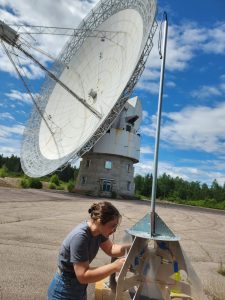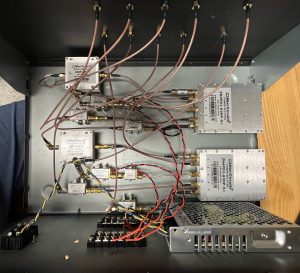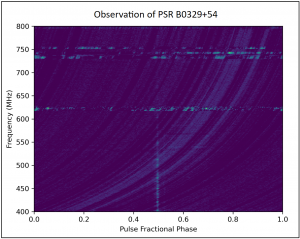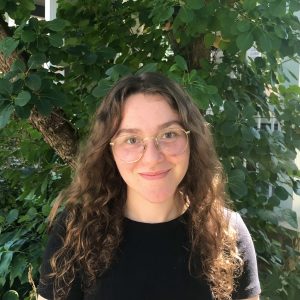Sophia is a fourth-year undergraduate student at the University of Waterloo studying physics and astronomy with a minor in mathematics. Sophia is originally from Oakville, Ontario but has been based in the Kitchener/Waterloo area since the start of their BSc.
Recently, Sophia has enjoyed participating in the University of Waterloo’s satellite design team, UW Orbital. Outside of the classroom, Sophia can be found outdoors—whether that be hiking or helping on the family farm in Orangeville, Ontario.
Sophia was awarded the 2023 Mercedes T. Richards Award for Excellence in Summer Undergraduate Research for their participation in SURP.
What made you decide to participate in SURP?
SURP offered me a great opportunity to conduct research within the Dunlap Institute, which plays a leading role in the advancement of astronomical instrumentation; something that I’ve recently become very interested in. I was hoping to work with Dr. Keith Vanderlinde given his expertise in radio instrumentation. When I found out he was willing to supervise me, it was an obvious choice to participate!
Can you tell us about your research project?
My project involved designing and building an ultrawide band (UWB) receiver chain for the 46-meter radio telescope at the Algonquin Radio Observatory (ARO). This involved developing a feed that collects weak signals from distant radio sources, along with the circuitry required to amplify them in order to be processed digitally. I deployed the receiver chain this summer and it’s currently operational at ARO with its main purpose being the study of pulsar scintillation.
Pulsars themselves are rapidly rotating neutron stars that emit beams of radiation at their magnetic poles; the astronomical equivalent of a light house! Their emitted radio waves scatter as they travel through the interstellar medium (ISM), which is the matter and radiation that exists between star systems within our galaxy. By studying this scintillation effect, we can learn about the properties of the ISM which is essential for understanding the structure and formation of our galaxy.
What is your favourite thing about SURP?
There are many aspects of SURP I enjoyed but my favourite part by far was getting to collaborate with some amazing people in radio! I was fortunate enough to work with researchers and students within the Long Wavelength Lab (led by Dr. Keith Vanderlinde), UTRAIN Lab (led by Dr. Juan Mena-Parra) and with Dr. Marten van Kerkwijk along with his graduate students. There was a strong sense of community within the groups, and through that, I gained valuable mentorship which helped me excel in my research.
Can you explain how SURP has been different from your undergrad work?
SURP is different from my undergraduate work as it has offered me creative freedom; I was able to take an experimental approach to learning through my research. Not only that, but astronomical instrumentation is also not as prevalent at my institution, so getting to learn about it first-hand from leading experts in the field was an experience like no other.
What are your plans for the future?
After completing my undergraduate degree, I plan to pursue graduate studies with a focus on astronomical instrumentation. With this, I hope to contribute to current and future projects that involve developing instrumentation that enable scientific projects which peer back into the early universe to better predict its origin and eventual demise. A fun way of time traveling one could say! But above all else, I plan to be fulfilled with the work I do and have fun along the way.

Sophia weather-proofing the feed before installing it on the 46-meter dish (seen in background) at the Algonquin Radio Observatory (ARO). Credit: Sophia Da Costa.

One of the four amplification stages designed and built for the receiver chain. Credit: Keith Vanderlinde.

The first pulsar observed with the receiver chain, PSR B0329+54. The strong vertical intensity line at a 0.5 pulse fractional phase are radio signals emitted by the pulsar. The horizontal lines are often radio frequency inference (RFI) sources such as telephone lines, TV channels, etc. Credit: Sophia Da Costa.
The Dunlap Institute for Astronomy and Astrophysics at the University of Toronto is an endowed research institute with over 80 faculty, postdocs, students, and staff, dedicated to innovative technology, ground-breaking research, world-class training, and public engagement.
The research themes of its faculty and Dunlap Fellows span the Universe and include: optical, infrared and radio instrumentation, Dark Energy, large-scale structure, the Cosmic Microwave Background, the interstellar medium, galaxy evolution, cosmic magnetism, and time-domain science.
The Dunlap Institute, the David A. Dunlap of Astronomy and Astrophysics, and other researchers across the University of Toronto’s three campuses together comprise the leading concentration of astronomers in Canada, at the leading research university in the country.
The Dunlap Institute is committed to making its science, training, and public outreach activities productive and enjoyable for everyone of all backgrounds and identities.

